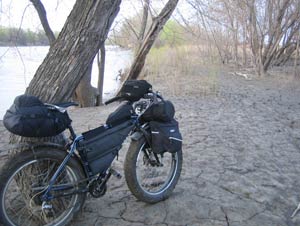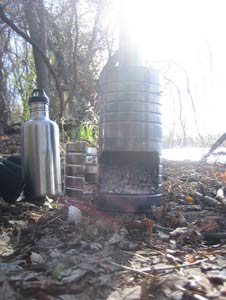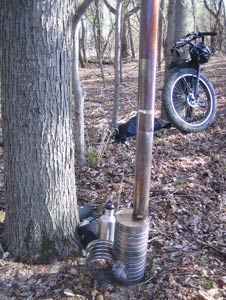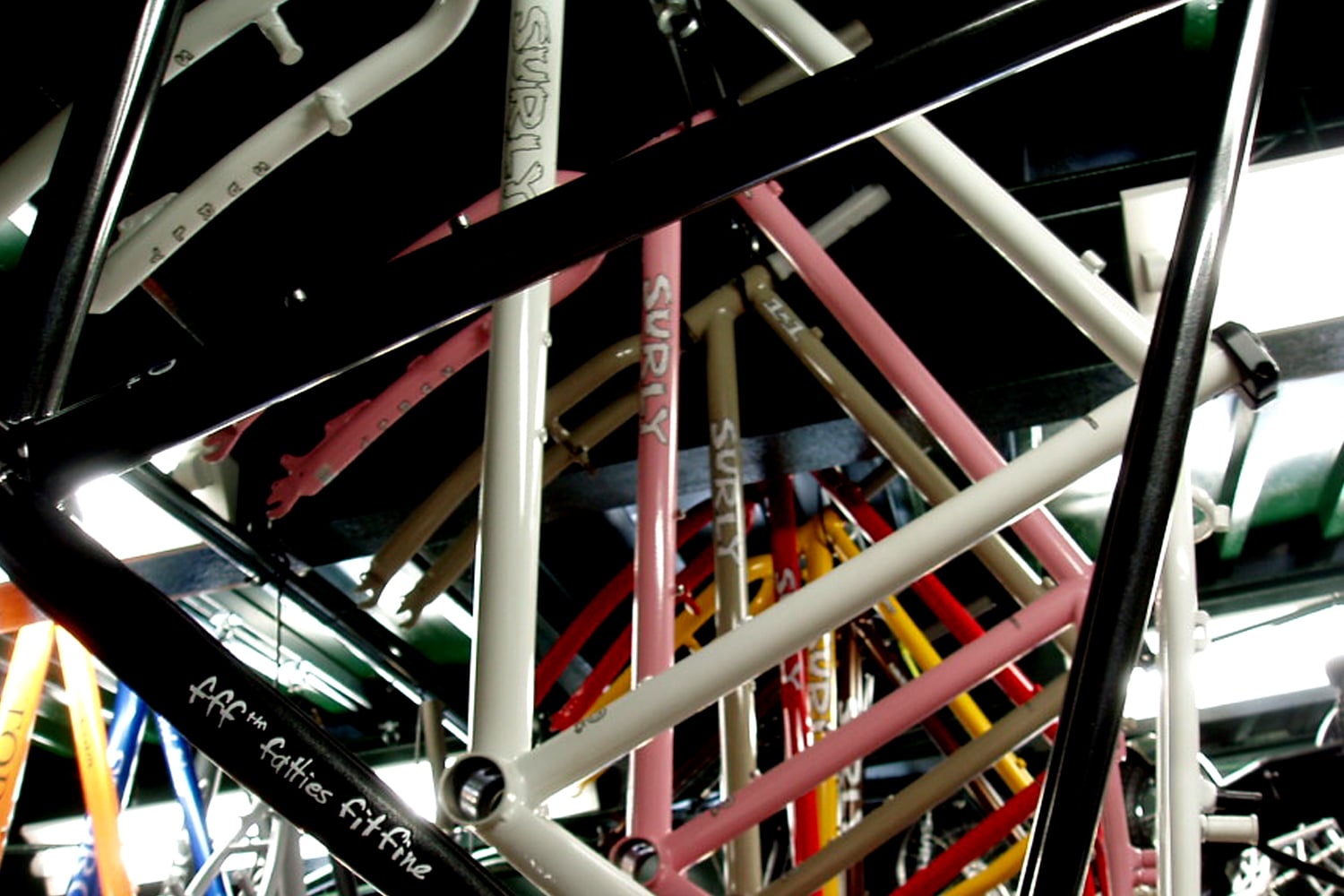The completion of a new stove, early last week, prompted me to pack up the Pug and take the scenic route to work, incorporating an overnight stay along the river en route. The Pugsley was definetely suited to the low spots on the trail where river juice and a previous day's light rain had turned the riverbank soil into slick, brown gumbo. Epic Designs frame bags, an Old Man Mountain front rack, and minimalist, modified Axiom panniers gave me ample room to securely carry all my gear over varying terrain.  When the sun dipped behind the horizon, I found a sweet site, 200 meters from the trail, and set up for the evening. Once again, my Hennessy Hammock was the chosen shelter, because it's a dependable vehicle to sweet dreams. It took me a couple years and some long, cool, sleep-deprived nights to figure out how to stay warm in this shelter when temperatures hover in the freezing range. But after a lot of experimentation with many kinds of insulation, I've found that the use of Hennessy's Undercover and Underpad, in conjunction with top and bottom quilts, creates one of the most comfortable beds I've used out of doors in the spring, summer, and fall seasons. A form-fitting, purpose-made underquilt is on the upgrade wish list. The newest stove, measuring 15cm in diameter x 30cm high, was positioned near the base of one of the trees supporting the hammock. I made this woodburner from three large coffee cans: 2 for the firebox, 1 cut apart for the door and miscellaneous bits. The firebox separates into 2 parts, so I can store my chimney, full Klean Kanteen, and rolled-up sitting pad inside it during transport. The internal pressure from the stored items keeps the stove from collapsing or denting when it is strapped to the top of my bike rack. It features an almost-airtight firebox, due to a close-fitting door and spotwelded construction, and a baffle to keep the flame from shooting directly up the chimney.
When the sun dipped behind the horizon, I found a sweet site, 200 meters from the trail, and set up for the evening. Once again, my Hennessy Hammock was the chosen shelter, because it's a dependable vehicle to sweet dreams. It took me a couple years and some long, cool, sleep-deprived nights to figure out how to stay warm in this shelter when temperatures hover in the freezing range. But after a lot of experimentation with many kinds of insulation, I've found that the use of Hennessy's Undercover and Underpad, in conjunction with top and bottom quilts, creates one of the most comfortable beds I've used out of doors in the spring, summer, and fall seasons. A form-fitting, purpose-made underquilt is on the upgrade wish list. The newest stove, measuring 15cm in diameter x 30cm high, was positioned near the base of one of the trees supporting the hammock. I made this woodburner from three large coffee cans: 2 for the firebox, 1 cut apart for the door and miscellaneous bits. The firebox separates into 2 parts, so I can store my chimney, full Klean Kanteen, and rolled-up sitting pad inside it during transport. The internal pressure from the stored items keeps the stove from collapsing or denting when it is strapped to the top of my bike rack. It features an almost-airtight firebox, due to a close-fitting door and spotwelded construction, and a baffle to keep the flame from shooting directly up the chimney. 
 Like my other stoves, this one is designed around the following criteria: * Low weight * Fast, tool-free assembly * Construction from low-cost or free, easy-to-find materials * Easy to transport on foot or bike * The means to boil water in a Klean Kanteen * Accommodations for my 130cm-tall roll-up stainless chimney I'm not concerned about the stove's ability, or lack thereof, to boil a liter of water in 5 minutes. I simply want to heat a small shelter or protected outdoor space with a small amount of wood, compared to an open campfire. If I get 500ml of water boiling in 20 minutes, I'm satisfied. The light and heat given off from one of these low-budget units adds to the camping experience, not unlike an open fire, while giving me the ability to control the combustion rate, focus the radiated heat, route the smoke up and away from my lungs, and keep the sparks confined to the firebox and chimney. The first firing was a success, but I have some fine-tuning and reinforcing to do before the next outing. This isn't the perfect stove, of course. It is, instead, a fast, inexpensive way to test design concepts in the field. The construction and design of the next stove will likely be much different than the current one. Eventually, I'll settle upon a list of specifications and features that will warrant the purchase of durable materials and justify the time investment required to build a stove that will last a number of years in the field. Good weather and an understanding spouse have allowed me to camp out one night per week for the last 4 weeks. I don't need to disappear for a week at a time. The 24-hour outings satisfy my desire to test/tweak my gear and enjoy some quiet time in the woods, without drastically disrupting my home and work life. If the weather forecast doesn't drastically change, I'll be back out there in a couple of days...making fire and geeking out on the design of the vessel that harbors it. -----
Like my other stoves, this one is designed around the following criteria: * Low weight * Fast, tool-free assembly * Construction from low-cost or free, easy-to-find materials * Easy to transport on foot or bike * The means to boil water in a Klean Kanteen * Accommodations for my 130cm-tall roll-up stainless chimney I'm not concerned about the stove's ability, or lack thereof, to boil a liter of water in 5 minutes. I simply want to heat a small shelter or protected outdoor space with a small amount of wood, compared to an open campfire. If I get 500ml of water boiling in 20 minutes, I'm satisfied. The light and heat given off from one of these low-budget units adds to the camping experience, not unlike an open fire, while giving me the ability to control the combustion rate, focus the radiated heat, route the smoke up and away from my lungs, and keep the sparks confined to the firebox and chimney. The first firing was a success, but I have some fine-tuning and reinforcing to do before the next outing. This isn't the perfect stove, of course. It is, instead, a fast, inexpensive way to test design concepts in the field. The construction and design of the next stove will likely be much different than the current one. Eventually, I'll settle upon a list of specifications and features that will warrant the purchase of durable materials and justify the time investment required to build a stove that will last a number of years in the field. Good weather and an understanding spouse have allowed me to camp out one night per week for the last 4 weeks. I don't need to disappear for a week at a time. The 24-hour outings satisfy my desire to test/tweak my gear and enjoy some quiet time in the woods, without drastically disrupting my home and work life. If the weather forecast doesn't drastically change, I'll be back out there in a couple of days...making fire and geeking out on the design of the vessel that harbors it. -----
 Surly Bikes
Bikes. Parts. Chaos.
Surly Bikes
Bikes. Parts. Chaos.
